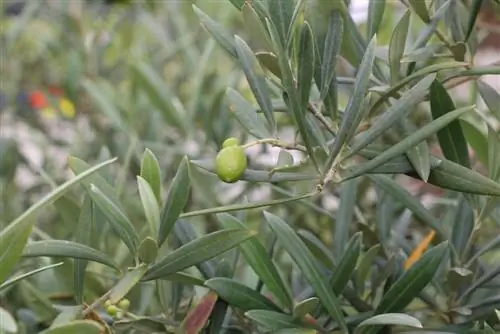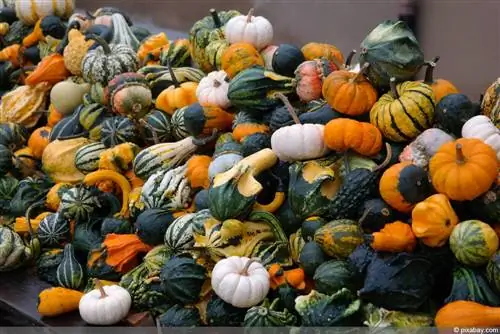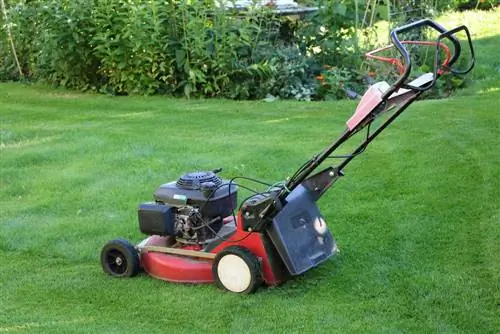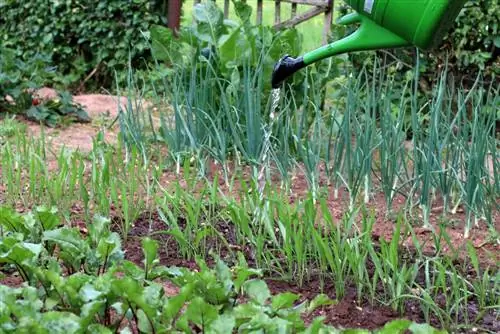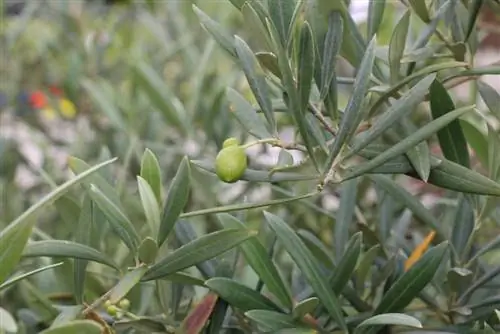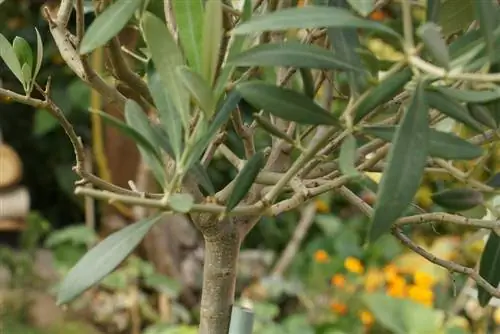- Author admin [email protected].
- Public 2023-12-17 03:39.
- Last modified 2025-01-24 12:45.
If the olive tree is given a sunny, warm location in the garden, it will produce its first flowers within 7 to 8 years of being planted. If it is a self-pollinating Olea variety, the first olives will not be long in coming. Now the question arises as to the correct harvest date, as the quality of the olives largely depends on this. A look at the calendar only helps to a limited extent. Read here which criteria you can use to make an informed decision about the perfect time for your first olive harvest.
Flowering time defines the time frame
Well-founded experience shows that an olive tree blooms for the first time after an average of 7 years. This applies under the premise that the Mediterranean plant benefits from a species-appropriate location and expert care. Young plants from the nursery are usually 3 to 4 years old, so you only have to wait a few years until the first flowering period.
The local light and temperature conditions determine exactly when the buds unfold. North of the Alps, the time window extends from the end of April to the end of June. In the mild climate of the wine-growing regions or along the Lower Rhine, an olive tree in a sunny spot is already in full bloom in May. Therefore, the time window for harvest opens several weeks earlier here than on the western border of the Black Forest or on the B altic Sea coast. Here the flowering period sometimes shifts into July, which results in a correspondingly later harvest time.
Self-fruitful, winter-hardy varieties are an advantage
When purchasing an olive tree from a specialist retailer, please ask whether it is a self-pollinating variety. Popular premium varieties, such as Arbequina, are not only hardy down to -11 degrees Celsius, but also produce hermaphrodite flowers. If the flowering tree is in the garden, pollination does not require any horticultural intervention because the wind takes over this task. By placing at least 2 olive trees in close proximity to each other, the harvest yield will still increase as a result of cross-pollination.
Tip:
Shortly before the flowering period begins, an olive tree must not suffer from drought stress and lack of nutrients. Otherwise the number of flowers will be reduced, which will also drastically reduce the olive yield.
From blossom to olive
Following fertilization, the yellowish-white flower turns into a drupe. This is spherical in shape and has a diameter of 1 to 2 cm and a length of 1 to 4 cm. The hard core is surrounded by soft pulp that is rich in various bitter substances. The process from fertilization to ripe fruit extends into autumn and winter.
Indicators for the harvest date
As the summer progresses, the first stone fruits will grow on your olive tree. These are small, green, very firm and far from edible ripeness. Please be patient until the following indicators signal that the harvest can begin:
- The olives have changed color from green to red-purple or black
- The pulp gives way under pressure
- The darker the color, the milder the aroma
If the weather conditions are normal, olives in the Central European climate will not reach the desired level of ripeness until mid/late November at the earliest. In connection with a late flowering period or under the influence of a wet and cold summer, the ripening period extends into December and January.
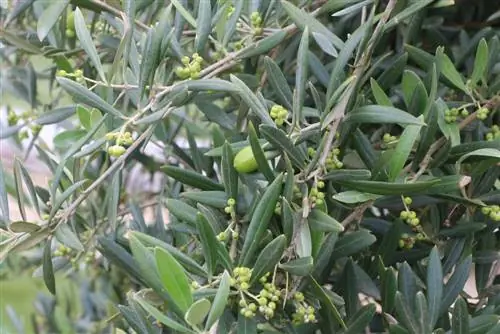
You are of course free to harvest the olives when they are green, as they are offered in stores. For all varieties, the green color means that the fruit is still unripe. Only a complex treatment with caustic soda makes them edible. With your own olive tree in the garden, you have the privilege of waiting for the fully ripe, black-purple state and harvesting olives of the highest quality.
Tip:
An olive tree always sets its buds the previous year. The shape and maintenance pruning in early spring should therefore be carried out as moderately as possible. The more the annual shoots are shortened, the fewer the number of flowers and fruits.
Rain protection is recommended
For an olive tree in a garden within hardiness zone Z8 or on the western edge of Z7, cool temperatures down to -10 degrees Celsius are not a problem. However, we recommend protection from wet and cold weather by providing a planted olive tree with a translucent, breathable hood. The root disc is covered with leaves and brushwood. In the pot, the tree should be under a canopy or similar rain protection. A cover made of bubble wrap keeps the root ball warmer behind the thin container walls for longer.
Tip:
If your olive tree produces a meager first harvest, don't let that discourage you. Even in its Mediterranean habitats, an Olea europaea only gives the gardener the maximum yield of rich olives at the age of 50 to 100.
Handpicking for best quality
In the large olive plantations along the Mediterranean you can watch the ripe olives being knocked from the tree with sticks. Shaking machines are sometimes used to shake the fruit from the branches and catch them in nets on the ground. Of course, these harsh methods affect the quality of the sensitive olives. By picking each ripe olive individually by hand, you ensure a premium quality harvest.
Tips for preparation
Olives fresh from the tree are far too bitter to eat, even when fully ripe. This does not mean that your olive harvest is only suitable for processing into oil. By watering the fruits for a long time, most of the bitter substances are removed from them. This is how it works:
- Slightly score a ripe, freshly harvested olive with a sharp knife
- To do this, cut the peel into the flesh at the narrow ends
- Place the olives in a plastic or glass bowl and cover completely with water
- Just place the lid loosely
- Place the bowl in a cool, dark place
In the following 4 weeks, change the water every 2 days. To do this, pour the olives into a sieve, clean the container and put the fruit back in with fresh water. After about a month in the water bath, the bitter taste improved significantly.
Preservation in brine
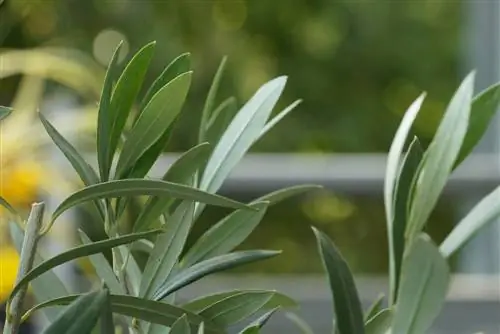
By placing the olives in a brine, you preserve the fruit naturally. Add 7 tablespoons of s alt to 1 liter of water and place the olives in it so that they are completely covered. By adding lemon slices, garlic cloves, thyme, pepper and a dash of wine vinegar, you give the olives a special flavor. This spice brine has a shelf life of up to 12 months in a sealed container.
Conclusion
In the full sun, warm location in the garden, the first flowering period on the olive tree does not take long to arrive. The green stone fruits of a self-pollinating Olea variety can be admired in summer, which raises the question of the right harvest time. As these instructions show, time as well as color and consistency are relevant to harvesting premium quality olives. Depending on the flowering period and the weather conditions, a harvest is possible from mid-November to mid-January. Green olives should remain on the tree until they have turned a black-purple color and the flesh is soft. The remaining bitter substances are washed out in a water bath. A brine enriched with spices ensures a long shelf life.

